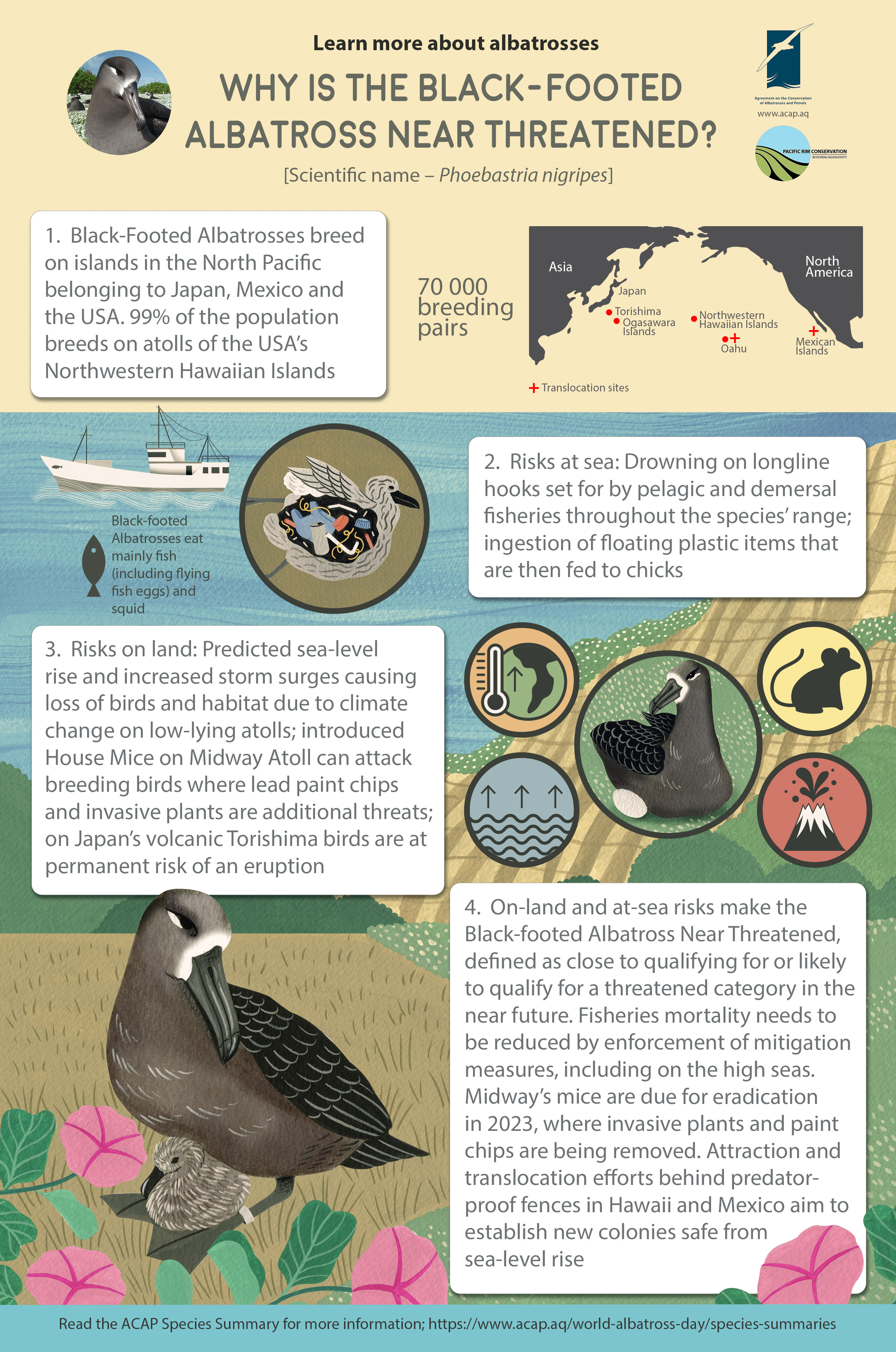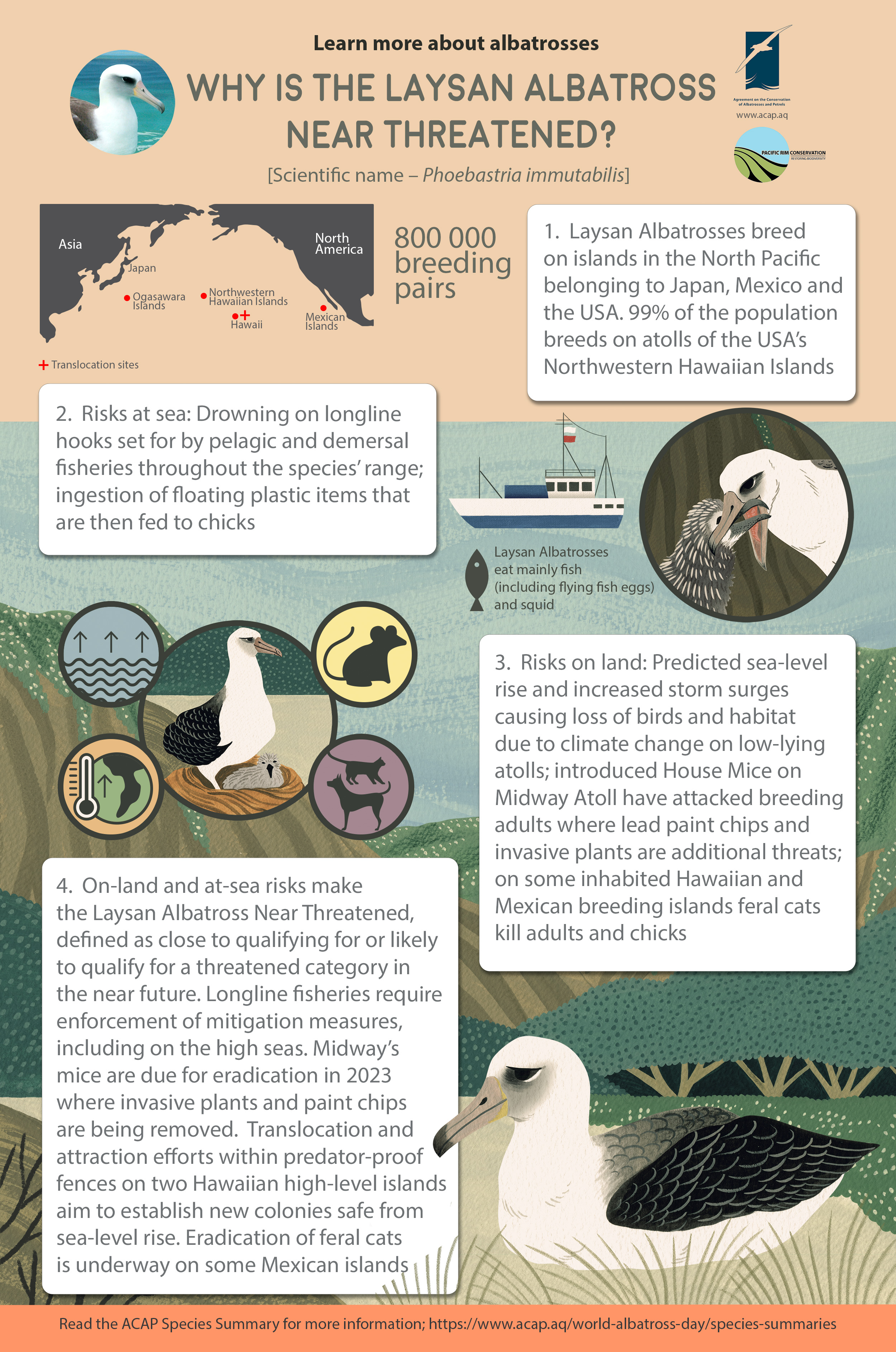
Two more infographics depicting conservation threats are released today for the Near Threatened Black-footed Albatross Phoebastria nigripes and the Near Threatened Laysan Albatross P. immutabilis. They have been produced in collaboration with the Hawaii-based environmental NGO Pacific Rim Conservation to support World Albatross Day 2002 and its theme of “Climate Change”.
Both these albatrosses have most of their breeding populations situated on the low-lying atolls of the USA’s Northwestern Hawaiian Islands. The atolls - and their breeding seabirds - are all at risk from predicted sea level rise and increases in the number and severity of storms that result in flooding, both considered a consequence of climate change. Storm floods have already caused at least one small sandy islet to disappear into the sea, losing breeding sites for several thousand albatross pairs (click here). Elsewhere in the island chain, as on Midway Atoll, storms have caused flooding of albatross nests and loss of chicks close to the shore.

Infographics in the three ACAP official languages of English, French and Spanish were produced earlier for the Critically Endangered Tristan Diomedea dabbenena and Waved Phoebastria irrorata Albatrosses and Vulnerable Wandering Albatross D. exulans to support World Albatross Day on 19 June 2021 and its chosen theme “Ensuring Albatross-friendly Fisheries”. In addition, a Portuguese version of the Tristan Albatross infographic takes note that the species visits the waters of Brazil. These three infographics were followed by a fourth in the same year, for the globally Endangered and Nationally Critical Antipodean Albatross Diomedea antipodensis, co-published with and sponsored by the New Zealand Department of Conservation in the three official ACAP languages. Two more infographics in English for the Endangered Grey-headed Thalassarche chrysostoma and Near Threatened Shy T. cauta Albatrosses were produced in the first half of 2022 (click here). They have been co-published with and sponsored by the Australian Antarctic Division.
All the infographics have been designed to help inform the general public, including school learners, of the threats faced by albatrosses and what is being and can be done to combat them. They serve to complement the detailed and referenced ACAP Species Assessments, the more concise and illustrated ACAP Species Summaries and the ACAP Photo Essay series.
The eight infographics produced to date may be freely downloaded at a high resolution to allow for printing professionally in two poster sizes (approximately A2 and A3). Please note they are only being made available for personal use or when engaging in activities that will aid in drawing attention to the conservation crisis faced by the world’s albatrosses and petrels – when ACAP will be pleased to receive a mention.
English and Portuguese language versions of infographics are available to download here, whilst French and Spanish versions can be found in their respective language menus for the website under, Infographies sur les espèces and Infographía sobres las especies.
Further infographics will be produced as new featured species are chosen to support future World Albatross Days, with the vision that, in time, all 31 ACAP-listed species will have their own infographic. Currently, an infographic for the Endangered Sooty Albatross Phoebetria fusca is in production and will be released soon. A further four infographics are to be sponsored by the Australian Antarctic Division for the Least Concern Black-browed Albatross T. melanophris, Near Threatened Grey Petrel Procellaria cinerea and for Northern Macronectes halli and Southern M. giganteus Giant Petrels (both Least Concern). These are all species that breed on Australia’s Macquarie Island. New Zealand’s Department of Conservation will sponsor its second infographic, this time for the country’s endemic and Endangered Northern Royal Albatross D. sanfordi.
Lastly, the environmental NGO BirdLife South Africa will sponsor an infographic for the Near Threatened Light-mantled Albatross P. palpebrata. With this sponsorship all four of the albatrosses that breed on Marion Island will have an infographic, helping drawing attention to the climate change driven threat they face from introduced House Mice, and the efforts being made by the Mouse-Free Marion Project towards ridding the island of its only remaining introduced mammal. It will also mean that all of Australia’s eight ACAP-listed breeding species will have an infographic, to become one of the first ACAP Parties to achieve this level of coverage.
Production will start on the six new infographics in the second half of the year, with the intention that they will be available for release by World Albatross Day 2023. French and Spanish versions will also be produced for all the new infographics.
With thanks once more to Namasri Niumim for her artistic work, and to Eric VanderWerf and Lindsay Young of Pacific Rim Conservation for their inputs.
John Cooper, ACAP Information Officer, 14 June 2022

 English
English  Français
Français  Español
Español